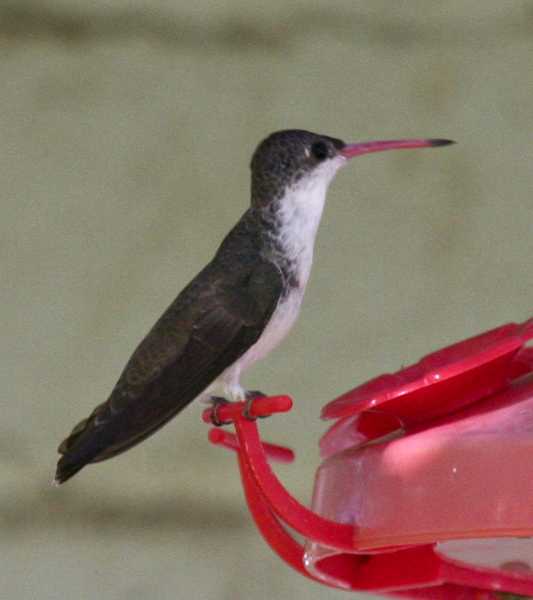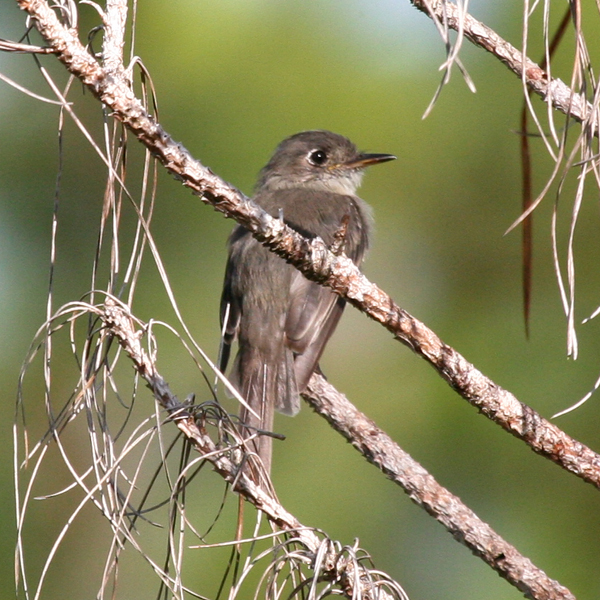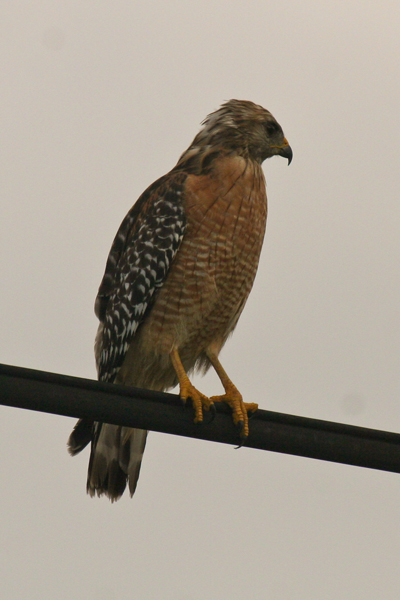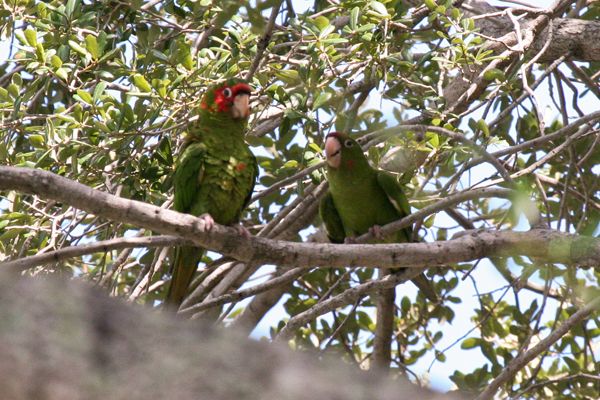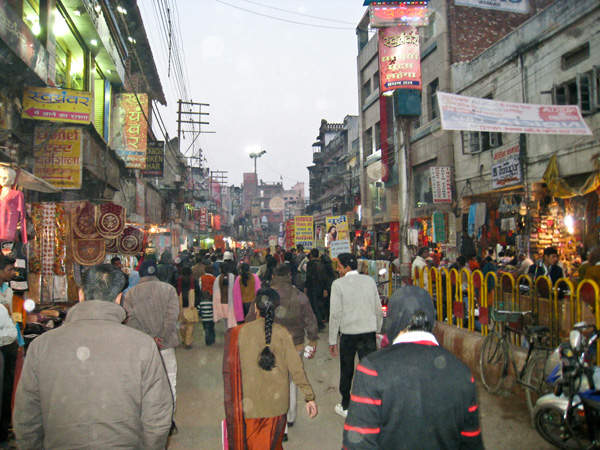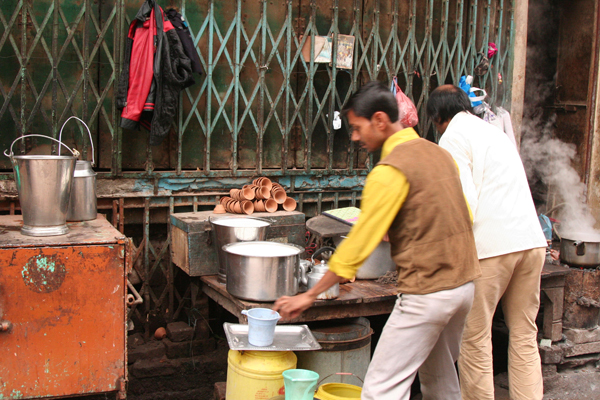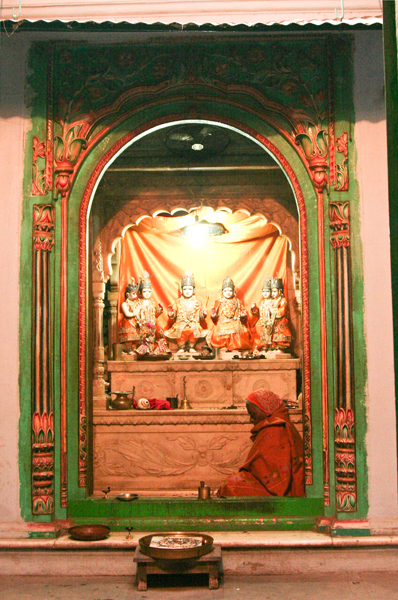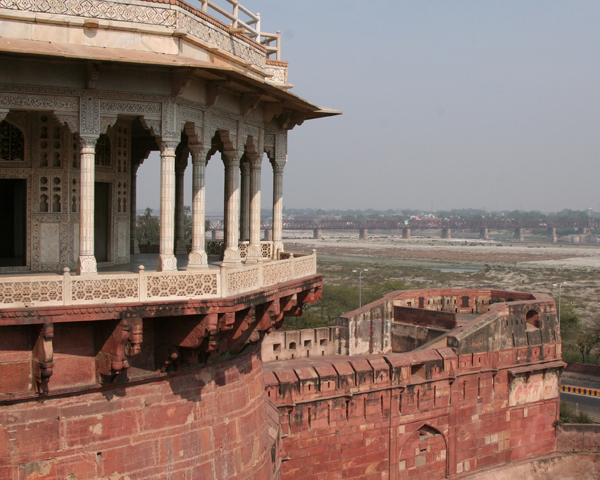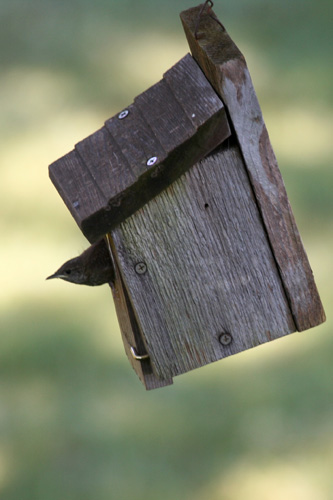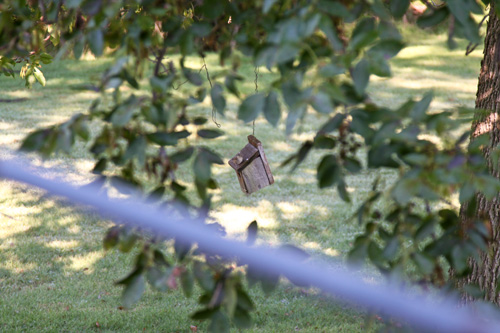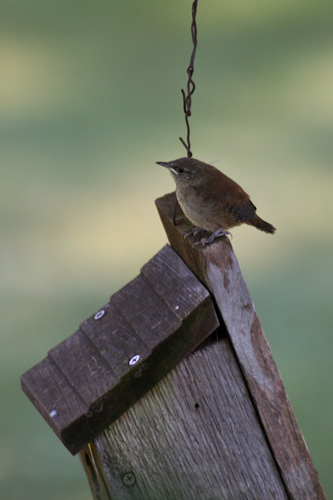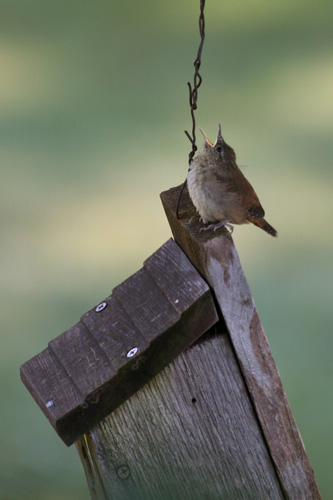Several weeks have passed since I posted the third installment of our report of our trip to India earlier this year . Here is the fourth installment.
Friday, January 29 One last look at the Taj Mahal from our balcony at the Oberoi. Then off by road and driver, Badel, to the deserted fortress at Fatehpur City, “City of Victory”. Built of red sandstone by Mughal Emperor Akbar for his three wives (one Muslim, one Hindu, and one Christian) and (far more numerous) harem, the biggest space by far was for the Hindu wife who finally bore him a son. We stopped in Bahratpur for lunch on the veranda of a hotel, and then went birding along a filthy canal with the AK representative who met us there, knowing I was interested in birds. We enjoyed the train ride of about 4 hours from Bharatpur to our second Tiger Preserve, Ranthambore, south of Bharatpur in the State of Rajesthan. The first-class car in which we rode was very nice, but the other cars were greatly overloaded with passengers. We were instructed to get off at the 5th stop, a village near Ranthambore, but it wasn’t clear how many of what we experienced along the way were “stops”. The porter, however, took very good care of us and two other American couples traveling on their own to the same destination. Late evening we arrive at the Oberoi Vanyavilas just outside Ranthambore. Oh my!! Such a fabulous place. Who could ever think that 3 nights in a “tent” could be so luxurious. It is like having our own house, with a few upgrades. (We later read in some travel literature that this hotel was rated number 2 in the world by Travel and Leisure Magazine). Dinner was served in an outdoor courtyard with a big fire pit in the middle. Tonight is full moon, clearly seen above the courtyard, together with Orion. It is like being in a fantasy world.

Saturday, January 30 Tea and cookies are served in the lobby to tide us over the early morning game drive into the park. We start out at 6:15 with our Ranthambore guide, Najeef. He is a friend of Jagat, who was our guide at Bandhavgarh, and he is exuberantly proclaiming that he is a much better guide than Jagat. The morning drive does not produce a tiger, but many birds, spotted deer, Sambahr and Nilgai.
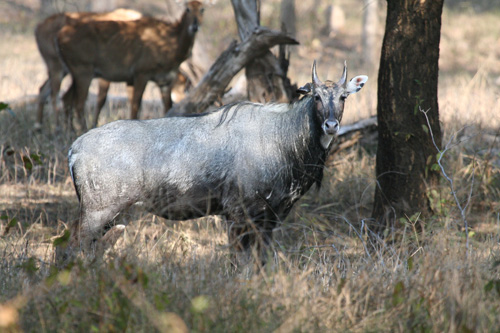
Back for a yummy breakfast of French Toast filled with ham and cheese and topped with maple syrup and whipped cream. Out again in the afternoon, but still no tiger. I did not go on this game drive (the “roads” in the park are rough) because my back and knee were both giving me a lot of pain. I enjoyed a quiet afternoon strolling around the grounds and finding a goodly number of new birds. We had another lovely dinner in the outdoor courtyard and retired early.
Sunday, January 31 Dawn arrives with another beautiful day. Tea and cookies were served and then we were off to a different part of the park. We saw a really big, beautiful tiger right up close. He was moving quickly, so Barbara did not get a picture, but it was a scene that we will both always have in our minds. We also saw gazelles, a mongoose, and 2 golden jackals. A good morning!

Relaxing time after breakfast and a shower. The afternoon game drive was another success with another tiger, this time a sleeping tigress. Such a beautiful animal! Back at the hotel we checked our email while having a “Manhattan”, which we concluded had been made from Scotch and Dry Vermouth, although we were assured the bartender really knew how to make Manhattans. We enjoyed another nice dinner in the courtyard and an early retirement.
Monday, February 1 Up early for our last game drive. In addition to us, there was an Indian couple and two “buddies” of Najeef’s in the jeep. Crowded, and not as much fun as the other drives. No tiger. But this Plum-headed Parakeet will do.

After breakfast and showers, we were off on the road to Jaipur with Badel at the wheel. It was hard to leave the Oberoi Vanyavillas-a fabulous place. We drove through many more poor villages, differing somewhat from our experience to the east of Rajesthan in being drier, more desert-like, with lots of camels, farm tractors and home-made vehicles. The women were busy, hard in farming, while many of the men were sitting around visiting with each other or playing some sort of dice game.
On the road to Jaipur.

We arrived in Jaipur and our Trident Hotel, checked in, and went over tomorrow’s itinerary with the Jaipur AK representative. We could see the Water Palace from our balcony, so we walked over to the lake for photos and birding, with a little begging from kids, but not bad.
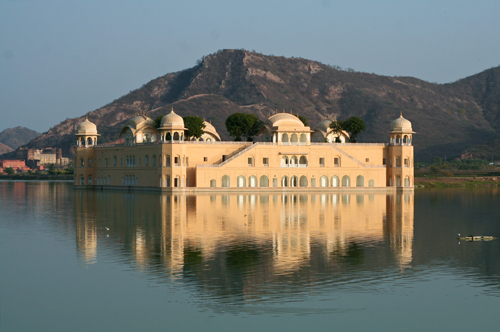
As Barbara sat on the balcony to write our trip journal, a Rhesus Macaque monkey jumped up on the railing, much to her chagrin. We have been warned that these little creatures can be dangerous because they have become accustomed to humans giving them handouts, and when one doesn’t they may become aggressive.
Tuesday, February 2 After a nice breakfast we were taken to Amber Fort by Badel and our Jaipur guide, Davindar. He was a very good guide, knowledgeable, good English, personable. The Amber Fort was once the capital of the state of Jaipur, until 1728. It is very large with a combination of Mughal and Rajput styles with frescoes, carvings and mirrored décor.

We then stopped at a gem factory, and they showed us some beautiful stones in hopes that we would do some shopping. We went on to Deva Amer where we rode on an elephant through the wilderness area. We were a little nervous about it at first, but we both enjoyed the experience a lot.
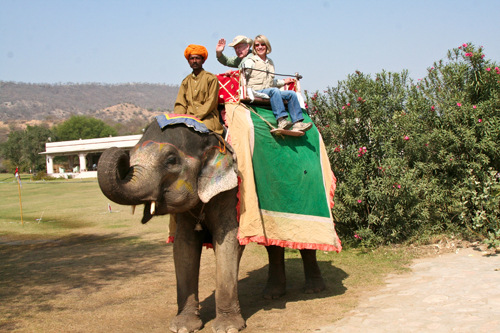
Nice lunch there. Back to the city to see Jantar Mantar, a fascinating outdoor observatory with large geometric structures for measuring time, celestial movements, etc. Then we moved on to City Palace to tour the museum and grounds. We stopped to take photos of Hawa Mahal, a red and pink sandstone façade built in 1789 for the women of the royal harem to look out one of the 953 small windows to see what was happening on the street below.
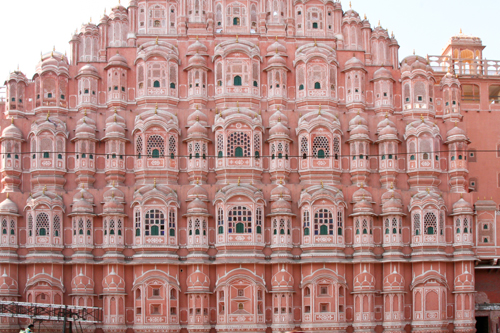
Our last stop was to look at carpets and textiles. Barbara chose a fabric and pattern at 5:00 to be made into a blouse, and they delivered it to our hotel at 7:00 as promised. It fit perfectly. This was a very busy but enjoyable day.
Wednesday, February 3 We got up at 4:40 to leave for the airport at 5:30 for our 7:00 flight to Udaipur. Everything went smoothly. The AK representative in Udaipur took us to the Trident Hotel. Our beautiful room was ready early, so we had a chance to have breakfast before leaving to tour the City Palace where the Maharana family still lives. It is a huge palace begun 400 years ago and still being enlarged..

Then on to see the Crystal Gallery with the world’s largest collection of cut crystal. We stopped to see how miniature painting is done, but did not stay to see the “sales room”. We are getting a little tired of being “encouraged” to buy the local art. Back to the hotel for lunch and some rest before taking a boat ride on Lake Pichola to see the city from the lake. We stopped at an island palace where Mughal Shah Jahan, builder of the Taj Mahal, lived in exile from his father. Back to the hotel to walk around the beautiful grounds. So thirsty for a cold beer, but no alcohol is sold from January 31-February 4 due to elections.
Thursday, February 4 More relaxing start this morning. We walked through the Garden of the Maids of Honor. Peaceful gardens, no fountains going due to major drought. Then on to Jagdish Temple, built by Maharana Jagat Singh in 1651. No photos were allowed. We left our shoes and socks outside. We bought marigold strands to leave as an offering at the huge black stone image of Vishnu. There were two priests reading scripture, and two men playing a drum and an accordion-type instrument. Being in this active temple was quite a moving experience. Our guide, Vic, is a Hindu and gave prayers. He gave himself and us a “third eye” of sandstone and saffron. From there we drove out of town to the old temples dedicated to Shiva. They were similar to those at Khajaraho, but not as many. We drove through the beautiful old Aravalle Hills to the 18th century Divi Garh Fort Palace high above the valley. We enjoyed a wonderful lunch there at their very contemporary white dining room. From there back to the entrance gate, we rode on camels. They laid down for us to mount up, then we were advised to hang on tight as they awkwardly got up, back-end first, nearly pitching us off over their heads. Camel rides are much bumpier than elephant rides, but a treat nonetheless. Back at the hotel we went birding and walking to the “sister hotel”, the Oberoi, and back.

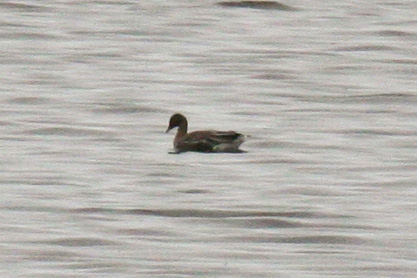
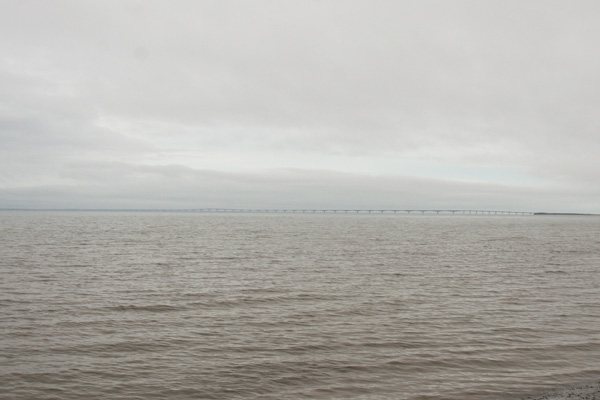
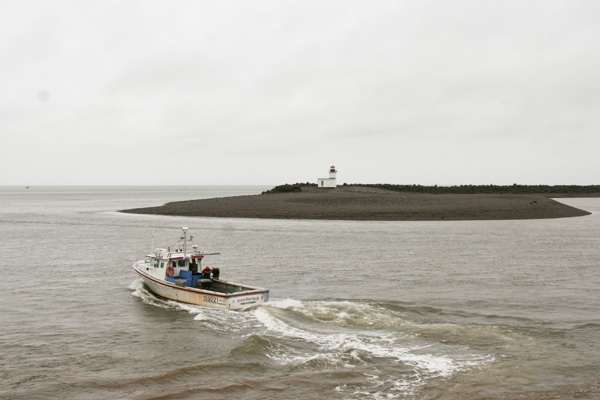





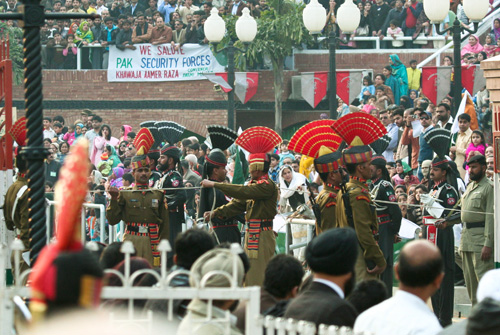
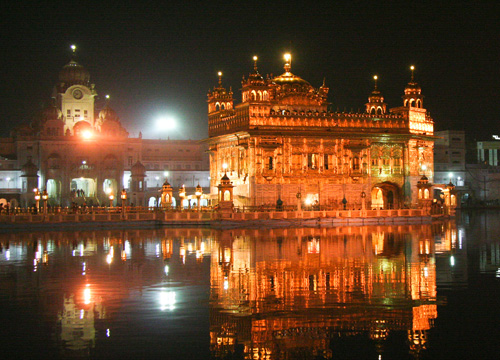
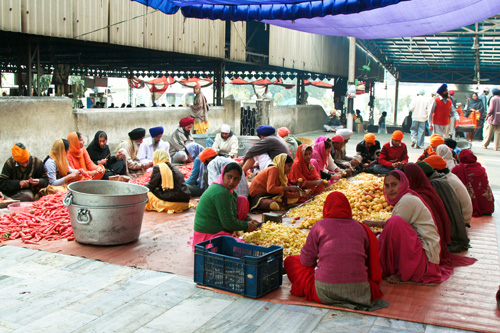
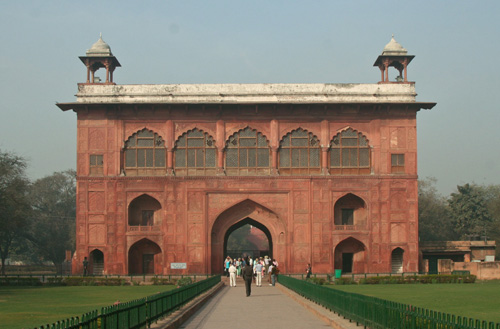
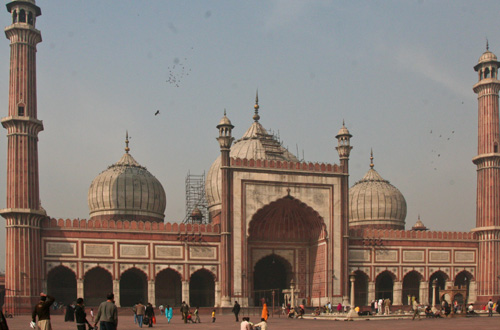
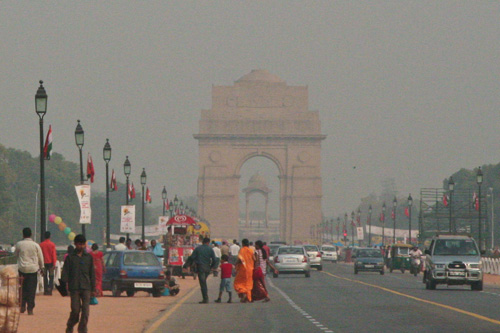
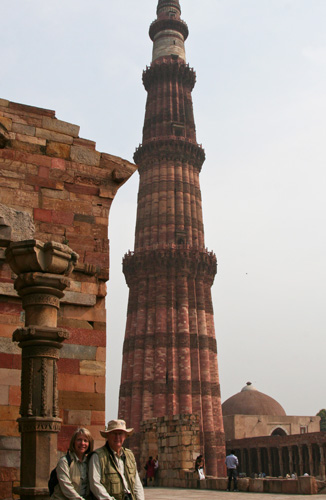











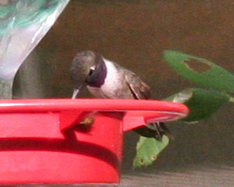 Violet-crowned Hummingbird
Violet-crowned Hummingbird